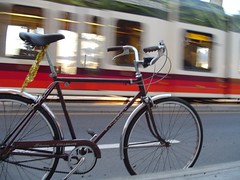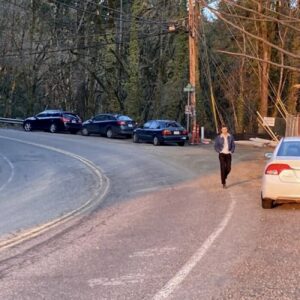
success of light rail corridors in making
decisions about active transportation funding.
(Photo © J. Maus)
A Metro task force put together to decide how the agency’s Joint Policy Advisory Committee on Transportation (JPACT) should spend $23 million in federal “flexible” funds, has agreed that the money set aside for active transportation projects — about three-fourths of it — should focus on just a few corridors at a time. The approach, similar to how TriMet has built out their light rail system, would be distinctly different than how our region has typically funded biking and walking projects.
The consensus around taking the “light rail model” funding approach was reached at a meeting Tuesday night. Here’s more from a statement published by Metro this morning:
“This would differ from the more scattered, piecemeal approach that Portland-area policymakers have typically used, which helped many communities across the region with small street, sidewalk, trail or bicycle projects. That approach has drawn criticism because it generated incremental improvements but not a complete new route.”
Back in July, JPACT voted to split the $23 million in Regional Flexible Funds roughly 75/25 between active transportation projects and freight-related projects.
More specific priorities for how to spend the money will be fleshed out by this task force in the coming weeks and will be presented to JPACT in January. Once allocated, money for this funding cycle can start being spent in October 2013. We’ll keep you posted on which bike-related projects might be in line for these dollars.






Thanks for reading.
BikePortland has served this community with independent community journalism since 2005. We rely on subscriptions from readers like you to survive. Your financial support is vital in keeping this valuable resource alive and well.
Please subscribe today to strengthen and expand our work.
At first glance, I really like this change. It seems like a good way to rally more citizen interest. When you have a million tiny projects, the average person (even an armchair transportation nerd) can’t possibly keep track of what’s going on. Contrast that with the development of a new light rail line, where it’s very obvious which improvements are going to be where. You can really develop a mental picture of what is going on.
As I read this, a signature project like npGreenway or Willamette Greenway would get a big jumpstart with a focused development of facilities. For trail advocates, the challenge is to be first in line.
This is great in my opinion. Now the question is which corridors to choose first.
I like the idea of this task force partnering freight and bikes. It seems natural that these two would be allies.
JPACT will go to Washington DC in March 2011 to present a list of regional transportation priorities for 2012 Appropriations. Washington County Coordinating Committee has on their list an Active Transportation project for the Fanno Creek Trail in downtown Tigard. The funds for this project would be spent on completing three sections of the trail, essentially to meander around the proposed Downtown Urban Renewal.
Who monitors the selection process for Active Transportation projects in WashCo? How are these projects prioritized? Would this task force or the Intertwine have a voice regarding project selection?
Seems that a proper crossing of Hall at Fanno in Beaverton ( the mid-block crossing, though my choice would be a redesign of the path to exit at a stoplight crossing of Creekside Place/Hall.) would benefit more commuting cyclists, more cross jurisdictional cyclists.
I thought the Mayor of Tigard, who along with Roy Rodgers are going to DC as JPACT reps, would not sign a letter sent last February from Blumenhauer asking for the Mayor’s support for the Active Transportation Act. He’ll not show support publicly but he’ll use funds in the name of Active Transportation to serpentine a path through a wetland.
What’s going on in WashCo with land use and transportation?
.
That’s a great question – maybe Hal Ballard could weigh in, or perhaps Jim Parsons?
Finally somebody recognizes the need for bicyclists to actually be able to get somewhere. Barbur improvements are a fantastic first step. Then maybe a route to Downtown from Gresham can be considered. Right now the best route is Burnside to Rockwood, then switch back and forth between Yamhill, Main, Mill and Market to Harrison which becomes Lincoln, get lost in Ladd’s Addition and somehow make it down to the Slpringwater/Willamette River trail. It’s almost faster to go the several miles longer Springwater Trail (which since the recent repaving is a magnificent trail we can now brag about). The Sullivan Gulch trail should be moved up in priority along with some sensible and safe ways to access it from the east side.
Good! The key to more bike use and less auto use is to create corridors that allow cyclists to travel greater distances at faster speeds.
Sullivan’s Gulch, Barbur Blvd., L.O. to SoWa trail, etc. would create the conditions for many to ditch their cars as cycling becomes the easier, less costly, and less time consuming commuting option. Let PBOT worry about “green neighborhoods” while Metro actually connects the entire metropolitan area with dedicated “bike freeways”.
Something that connects the areas from Tigard and Lake Oswego into downtown is badly needed. 99 really isn’t as great a bike route as you’d think. The west side has made some improvements over the past couple years, but it is still a far cry from facilities available on the east side like the Springwater. Not that these routes need to be all on off-street paths, but they do need to be complete. It is very frustrating to be riding on a street with a bike lane one minute, then the street turns into a two-lane divided highway with no shoulder the next.
Unfortunately, $23mil isn’t going to go very far (though that’s what, 23 miles of off-street path?), but they might be able to fund one complete route if they are smart and frugal about it.
they’d prefer you all cram onto a stinky crowded Tri-met train! it’s the way of the future!
You’re funny!
I’m not trying to be.
How about some of that money being spent on the Capitol Highway rebuild, where one option is to introduce sidewalks and a cycle track?
Man, this city is just not on the ball with these things.
I urge anyone to go to the Open House Dec 14th to voice support for the cycle track option!!
http://www.portlandonline.com/transportation/index.cfm?c=51637
FYI, there was an article in the Oregonian a few days ago about this:
http://www.oregonlive.com/portland/index.ssf/2010/12/southwest_portland_open_house.html
Creating complete working facilities is the first step to proving to the non-cycling public that this is a valid funding choice that has achieved something substantial.
Dramatic leaps forward in infrastructure will produce dramatic effects on bicycle traffic safety.
As our society is attuned to the dramatic this should help our cause.
Couldn’t hurt to include explosions and beautiful people for the TV news crews.
$23 million doesn’t amount to much in the grand scheme of things, but if a great 3-6 mile corridor could be developed with that much money every two years, we could create some pretty amazing bike corridors throughout the city. The Sullivan’s Gulch Trail could create 1,000’s of new daily bike commuters because it makes such great connections between I-205, inner NE/SE neighborhoods, and downtown.
The money could also be used to leverage other available funds.. for instance, it could’ve been used to develop a continuous separate bike path between SE Clinton and downtown Portland via the new Portland-Milwaukie bridge…
This is very, very intriguing. Can’t wait to hear more.
I’d like to see a path from Beaverton into downtown without having to get onto MAX, or make the climb through forest park.